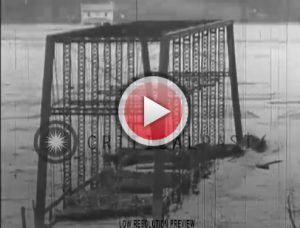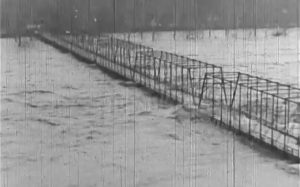Town of Brunswick Escapes With Comparatively Slight Damages,
But B&O Railroad Suffers Heavy Losses From Water Which Covered Yards.
Reprinted from The Brunswick Citizen, May 5 & 12 & 19, 1983 issues; originally appeared in the Brunswick Blade-Times, March 1936.
Reprinted from The Brunswick Citizen, May 5 & 12 & 19, 1983 issues; originally appeared in the Brunswick Blade-Times, March 1936.
Compiled from clippings, files and photos in the Lovettsville Museum archives & online sources,
by Melani Carty, Board Member, Lovettsville Historical Society & Museum.
The worst flood in the history of Brunswick which swept through the Potomac River Valley last Wednesday [March 18-19, 1936], was experienced locally as well as elsewhere along the route of the stream, causing property loss reaching into the millions of dollars, and untold suffering throughout the area.
While residents watch the rapidly rising water, Wednesday morning, no one gave any thought to the gravity of the situation which was to follow, and none anticipated the extent to which the Potomac would spread at this point. It was not until the river was about to overflow the bank bordering the C&O Canal, that the gravity of the situation was realized, and those residents in the lower section of town began to remove valuables and household effects to places of safety, while railroad officials and employees began the work of removing as much equipment and freight from the lower levels of the railroad yards and shops, as possible, and those engaged in business along the railroad were likewise busily engaged in removing stocks to higher levels.
All those affected by the flood, except in a few instances, waited too long to begin moving, and much property was caught in the flood and either damaged or ruined completely.
Engines Moved To Hump
Twenty-one locomotives in the vicinity of the local shops of the B&O Railroad were removed to the east bound freight classification yard, west of town, where they escaped damage by the flood. Much freight in the lower yards was also removed to the hump west of town and likewise escaped damage. The moving of engines and cars was continued until early evening, when water rose to such depth over the tracks that it was no longer safe to venture into the flood. Although much freight was moved out of the flood area, there were many cars which had to be left in the flood. Several tracks filled with loaded freight cars remained in the flooding area, and while water reached a height above the floors, it was reported very little damage resulted to the shipments, due to the nature of the cargoes.
While train crews were engaged in removing engines and cars out of the flooded section, employees in the various other railroad departments were engaged and preparing for the inundation. Electric motors were removed from the turntable at the shops and taken to a place of safety, while the personnel of the shops, offices, store room, etc. hastily prepared to vacate.
Six Feet of Water On Tracks
About 3:30 o’clock Wednesday afternoon the flood water began overflowing the north bank of the C&O Canal and onto the eastbound tracks of the railroad. Despite the wide expanse over the large yard, the flood continued to rise with almost unbelievable rapidity, and continued until early Thursday morning, when the water attained a depth of about six feet over the tracks, and at some points the depth was greater.
The store-room, powerhouse, round house, offices, station, YMCA basement, etc. were flooded to a depth of about six feet, except in the basement of the Y where the depth was about 3 1/2 feet in the washroom and bowling alleys. Early Thursday morning, when the flood reached its crest, the stream was overflowing East Potomac Street at Fourth Avenue and also covered Walnut Street. Basements of homes adjacent to the stream passing under the street at Fourth Avenue were flooded almost to the floors, as was also the case at the stream passing under the same thoroughfare in the rear and the doctor A.G. Horine premises, the floodwater filling the basements almost to the floor at the Lace Store, Ephraim’s, and at Gross Bros. The flood, at its crest, spread into the garage of Dr. A.G. Horine and covered a portion of his lawn bordering East Potomac Street.
Water Overflows Bridge Floor
Early Thursday, when the water attained its highest point, the swell poured over the floor of the Potomac River bridge at two places, but despite the high water and strong current, which carried buildings of every description, livestock and personal effects, to say nothing of driftwood, trees, etc., the bridge spanning the Potomac here withstood the tremendous strain. It is the only river bridge remaining between Washington and Williamsport, all the others having been either totally or partially carried away.
B&O Loses Water Supply
When the danger of the flood became apparent, the pumps at the local shops, supplying water for locomotives, boilers, etc. were started, and all tanks filled, in order that a sufficient supply of water might be available for immediate use when the flood subsided. But the effort was futile. Buildings, cross ties, etc., carried downstream by the strong current, collided with fire hydrants in the railroad yard, snapping them off, and permitted the reserve water supply to escape into the flood.
Their water supply gone, and no means available for furnishing water for locomotives, firehose was connected to the town main, and water from the municipal system was made available for the use of the company until repairs could be made to the latter system and pumps started, which was accomplished late Friday evening.
Many Buildings Lost
As the flood increased, various buildings in the path of the flood were lifted and were carried downstream, some parts of which were later recovered and returned to their former locations.
The bunkhouse, situated between the Potomac River and the canal, west of the river bridge, was swept away, the occupant having vacated the building early Wednesday morning, taking their personal effects with them.
Many cabins and summer cottages erected along the Potomac, both east and west of Brunswick, were likewise caught in the flood or damaged, without exception. While most of these buildings were swept away entirely, a few were dashed against and lodged among trees. Only one cottage, that of Charles Barger, this city, situated east of town, opposite the westbound hump, withstood the flood. Mr. Barger had wired his cottage to trees prior to the flood, which saved it from being swept away. It was damaged, however.
Train Service Disrupted
Train number 11 from Baltimore and the east, was the last train to reach this terminal Wednesday morning, prior to the flood. It was not until Friday afternoon when another train came into the terminal, which was a special made up in Washington, and running as No. 31, arrived here about 4:30 o’clock. On Saturday, Train 31 succeeded in getting through as far as Martinsburg, and returned as No. 16. Schedules continued to be thrown aside and train service was decidedly disrupted until Monday, when near-normal service was again established.
An effort was made Friday to route trains westward via Hagerstown, but, due to washouts on other lines, this was impossible. The Capitol Limited was said to have been routed via Hagerstown Friday, but was unable to follow the route anticipated, and finally steamed into Rochester, New York.
In order to clear the local yard of an accumulation of freight consigned to points on the Shannondoah Valley division, a special train was dispatched from this terminal at 10:30 a.m. Saturday for Charles Town, W. Va., via Shenandoah Junction and over the Norfolk and western tracks.
Reprinted With Permission from The Brunswick Citizen Newspaper
Floods of Harpers Ferry, 1748-1996
by Dave Gilbert
http://www.dgilbert53.net/?page_id=832
NEWSREEL: Flooding in Williamsport, Maryland; Point Of Rocks, Maryland; and Washington DC, From the Great Potomac River Flood of 1936
March 18-19, 1936
NEWSREEL: The Great Potomac River Flood of 1936
The Great Potomac Floods
From “Smoke Town History, Brunswick, Maryland” Facebook Group
Photo of the 1936 Flood, courtesy of Kim Myers
C&O Canal Devastated by the 1924 Potomac River Flood
“Down the Old Potomac” On the C&O Canal; A Thomas Edison Film (1917), is a silent, black & white film, depicting the Chesapeake & Ohio Canal, back in the days (1831-1924) when it was operational, with water, locks, gates, towpath, and boats. The C&O Canal was used to transport goods from Cumberland, Maryland to Washington DC, but was ruined in 1924 by Potomac River flooding and subsequently abandoned. Today the C&O Canal towpath has been repurposed as a popular 184-mile-long bike trail.


